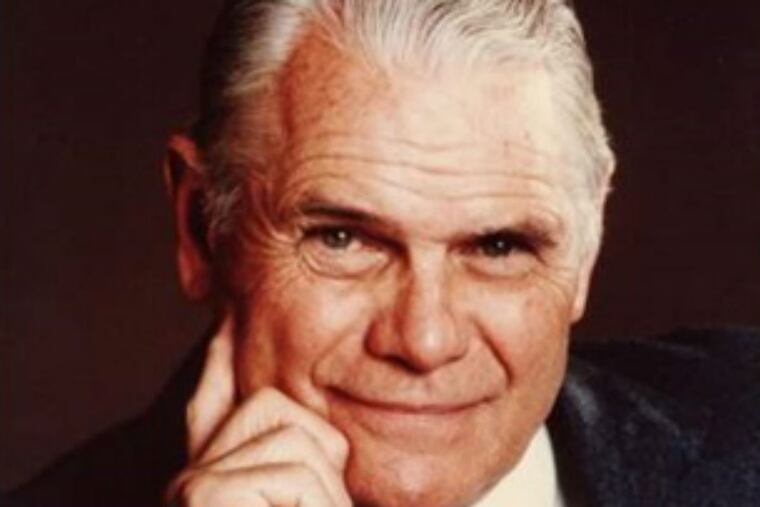Dr. Howard H. Steel, 97, Shriners Hospital chief surgeon and orthopedic trailblazer
Dr. Steel was a noted innovator in medicine, but he had many other interests and urged others to pursue theirs, too.

Dr. Howard Haldeman Steel, 97, of Villanova, an internationally known chief of orthopedic surgery at Shriners Hospital for Children in Philadelphia whose contributions to medical science helped patients with spinal and pelvic conditions, died Wednesday, Sept. 5, in Montana.
Dr. Steel was recovering from a stroke in a hospital near his family's summer home when he suffered cardiac arrest, said Scott Kozin, the chief of staff at Shriners Hospital.
"He was an icon in Philadelphia and a true Renaissance man," Kozin said in a statement circulated to hospital staff. "He embodied the mission of Shriners Hospitals for Children — research, education, and patient care. Dr. Steel treated thousands of kids with difficult problems and truly changed their lives for the better."
Dr. Steel pioneered some of the most innovative surgical treatments within the orthopedic field, and many are still in use. In one such procedure, he took a nontraditional approach to patients with debilitating deformity of the spine, using a cast and gravity to correct the spinal curvature.
Dr. Steel's triple osteotomy — an operation he devised to realign the hip socket in patients whose hip sockets are too shallow — remains the foundation for pelvic surgery in children, Kozin said.
Steel's Rule of Thirds — in which he quantified for surgeons the safety zone within the spinal cord as one-third cord, one-third bone, and one-third space — is also part of the orthopedic lexicon.
And his hemipelvic resection — a special way of removing malignant pelvic tumors by excising part of the pelvis — spared many patients an amputation of the leg, Kozin said.
In 1966, Dr. Steel was appointed chief surgeon at Shriners Hospital and a professor of orthopedics at Temple University School of Medicine. In 1980, he established the first spinal-cord-injury center designed specifically for children at Shriners. The program was so successful that it became the pilot for other Shriners Hospitals across the country.
Dr. Steel was a founder of the Eastern Orthopaedic Association and served two terms as president, from 1969 to 1971. He was also an enthusiastic teacher, educating residents "with fervor, lectures, and laughter," Kozin said. Dr. Steel wrote widely and held 71 visiting professorships around the globe.
But Dr. Steel's life was packed with far more than just orthopedics. He savored travel, wine, sailing, skiing, tennis, squash, horseback riding, fly fishing, and reading, and he urged his students and colleagues to pursue their nonmedical interests.
In keeping with that philosophy, a group of his patients founded the Howard H. Steel Orthopaedic Foundation in 1981. The foundation funds lectureships on any subject except orthopedics or medicine.
"Whether it was an innovative surgical procedure, or a breakthrough diagnosis, his journey of discovery was the same: he believed that true creativity comes from seeing old things from new angles — and that fresh perspectives are born out of pure enjoyment, intellectual curiosity, humility, and above all, humor," said Dr. Scott D. Boden, an Emory University School of Medicine professor and a past president of the American Orthopaedic Association.
Born in Philadelphia and raised in Atlantic City, Dr. Steel was part of the family that sells Steel's Fudge on the Boardwalk in Atlantic City and at other New Jersey locations.
He earned a bachelor's degree in chemistry from Colgate University before serving in the Navy during World War II. Afterward, he completed a medical degree at Temple University School of Medicine in 2½ years, and a residency in orthopedics at Temple. He went on to serve on the faculty for the next two decades.
Later, he earned a doctorate in anatomy while a visiting professor at the University of Washington. He was affiliated with Thomas Jefferson University, St. Christopher's Hospital for Children, and the Hospital of the University of Pennsylvania.
Dr. Steel doted on his wife, Elizabeth Clack Steel , or Betty Jo, whom he married in 1964.
Besides his wife, he is survived by children Anna Betterton Steel and Howard Haldeman Steel Jr.; stepchildren Celia Smith Carroll, Turner Cary Smith, and Townsend Cary Smith; children from a previous marriage, Michael Steel, Kathy Steel Boney, and Patrick Steel; 11 grandchildren; and two great-granddaughters. A brother, and his former wife, Nancy Steel, died earlier.
A celebration of life is being planned for November at the College of Physicians in Philadelphia. Burial is private.
Memorial donations may be made to Shriners Hospital for Children, 3551 N. Broad St., Philadelphia, Pa. 19140, Attn: Development Office.